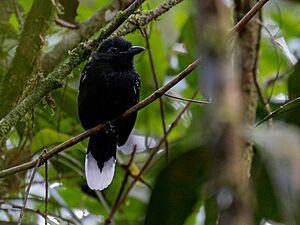Band-tailed antshrike facts for kids
Quick facts for kids Band-tailed antshrike |
|
|---|---|
 |
|
| Male | |
| Conservation status | |
| Scientific classification | |
| Genus: |
Thamnophilus
|
| Species: |
melanothorax
|
 |
|
| Synonyms | |
|
Sakesphorus melanothorax |
|
The band-tailed antshrike (Thamnophilus melanothorax) is a cool bird that lives in parts of South America. It's a type of "typical antbird" and belongs to the family Thamnophilidae. You can find this bird in Brazil, French Guiana, Guyana, and Suriname.
Contents
About the Band-tailed Antshrike's Name
How Scientists Name Birds
The band-tailed antshrike was first described by an English zoologist named Philip Sclater in 1857. He gave it the scientific name Thamnophilus melanothorax. This two-part name is called a binomial name. It helps scientists around the world know exactly which species they are talking about.
Why Its Name Changed
For a while, this bird was placed in a different group, or genus, called Sakesphorus. But scientists later did a special study looking at the birds' DNA. This study, published in 2007, showed that Sakesphorus wasn't a single natural group. It turned out that the band-tailed antshrike and two other species actually fit better with birds in the Thamnophilus genus. So, the band-tailed antshrike was moved back to its original group.
One of a Kind
The band-tailed antshrike is a monotypic species. This means it doesn't have any different subspecies or types within its species. It's just one unique kind of band-tailed antshrike!
What Does the Band-tailed Antshrike Look Like?
This bird is about 16 to 17 centimeters (6 to 7 inches) long. One bird weighed about 31 grams (1.1 ounces). Birds in the Thamnophilus group are fairly large antbirds. They all have strong beaks with a hook at the end, much like a true shrike bird.
Male vs. Female Birds
- Males: Adult male band-tailed antshrikes are almost completely black. They have a hidden white patch between their shoulders. They also have small white spots on their wings. The most noticeable feature is a wide white band at the end of their tail, which is how they got their name!
- Females: Adult females look quite different. They have a bright, deep reddish-brown color on their head, back, wings, and tail. Their face, throat, and chest are black. The rest of their belly is gray, with a reddish-brown tint on their sides and under their tail.
Where Does the Band-tailed Antshrike Live?
Its Home Range
You can find the band-tailed antshrike in southern Guyana, across Suriname and French Guiana. It also lives in northeastern Brazil, especially in the Amapá state. There's even been one sighting near Manaus in Brazil's Amazonas state.
Its Favorite Places
This bird mostly lives in the lower parts of evergreen forests. However, it can also be found higher up in the middle parts of the trees. It really likes dense vines and other plants that grow in open spots. These open spots are often created by fallen trees or old clearings made by people. You might also see it in swampy areas or thick bushes along rivers. It lives from near sea level up to about 550 meters (1,800 feet) high.
How Does the Band-tailed Antshrike Behave?
Staying Put
Scientists believe the band-tailed antshrike stays in the same area all year round. It doesn't seem to migrate or move to different places.
What It Eats
We don't know a lot about what the band-tailed antshrike eats. But it's thought to mainly eat insects and other small arthropods, like spiders. It usually looks for food alone or with its mate. It rarely joins large groups of different bird species feeding together.
How It Finds Food
This bird mostly searches for food in thick plants close to the ground. It can also forage up to about 10 meters (33 feet) high. It finds its food by picking insects off plants, vines, branches, and even the ground.
Raising a Family
Sadly, not much is known about how the band-tailed antshrike breeds or raises its young. Scientists still have a lot to learn about this part of its life!
Its Calls and Songs
The band-tailed antshrike's song is a slow series of 7 to 9 low, hollow "ah" notes. The notes get a little faster as the song goes on. Its call sounds like a quiet, muffled, and nasal growl. Sometimes it makes this growl twice in a row.
Is the Band-tailed Antshrike in Danger?
The IUCN (International Union for Conservation of Nature) has looked at the band-tailed antshrike's status. They have assessed it as being of "Least Concern." This means it's not currently considered to be in immediate danger of disappearing.
It lives across a large area. However, we don't know exactly how many band-tailed antshrikes there are. Scientists believe its population might be getting smaller. No big threats have been found right now. Even though it seems to be a rare bird that doesn't live in large numbers, there are still big areas of good habitat left in Suriname, French Guiana, and Brazil (Amapá).


